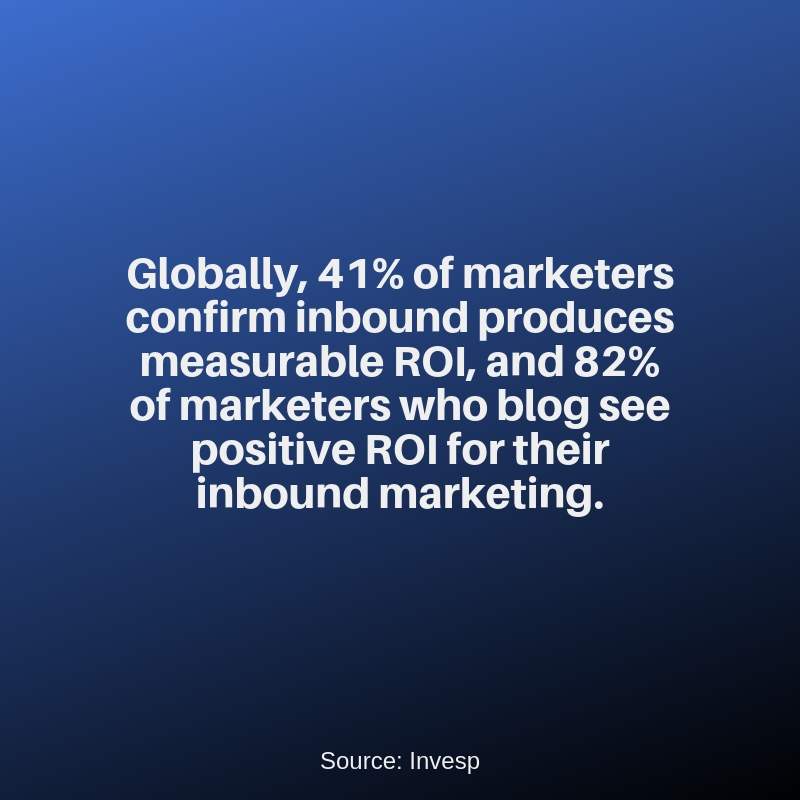Honestly look at your website. Is it filled with sales pitches? Is it all about you? Well, that’s all brochure type outbound marketing. The thing is your website isn’t just a brochure or a glorified business card. Your site is also a means to capture attention, connect, and build trust with consumers. This article discusses the three main things required to transform your site into an inbound marketing machine.
Don’t get me wrong. There’s nothing wrong with brochure type outbound marketing if it’s mixed with some inbound tactics. Inbound marketing is about bringing customers to you, while outbound is about interrupting them. Every business must find the perfect blend between the two. Ideally, you shouldn’t have one without the other but today you need more inbound marketing.
Inbound Marketing Examples
Adding a blog that’s regularly updated with new information to a website is an inbound marketing strategy. People may find you online through search engines, social media channels or blog directories because of your blog. Similarly, an online forum that lets people share and chime in on conversations is an inbound marketing tool. Inbound marketing attracts consumers and gives them a reason to come back.
So how do you know if you’re using inbound marketing?
In general, you should be able to answer ‘yes’ with a good reason for the following questions.
Will your website continue to attract people to it without you having to “push” all the time and why?
Will first time visitors ever return to your website and why?
You’re doing a good job at inbound marketing when your site can attract qualified visitors without any added effort on your part. And some of them return.
Advertising methods like cold calling, email outreach, TV, radio, etc. are all forms of outbound marketing because they interrupt the potential customer. Again, there’s nothing wrong with this but it shouldn’t be your only means of marketing.

Your Website is Only The Beginning
Although your website is very important, it’s only one part of inbound marketing. Some of your time should be spent working on content outside your site. Creating communities and building relationships outside your website is also essential for growing your own web traffic.
We’ll call them ‘assets’. Each asset should be an extension of your company. Think of them as inbound marketing tools that help you grow by forming connections with your target customers.
A business that develops a presence on Facebook, Medium, and YouTube will naturally attract more customers online than one without these assets. Providing that their content is engaging, useful, and in line with the intended audience, including product offering.
What is “Useful” Content?
‘Useful’ isn’t just about publishing non-promotional pieces like many incorrectly assume. Promotional content can be useful too.
Here’s a really simple example. A local hair salon owner that shares pictures of their best work on Facebook is being useful. Why? This is because consumers can take a journey into the quality of their services. Hair enthusiasts will love it and perhaps, even spread it. Overall, they’re helping prospects make a decision and plenty of people just need a reason to say ‘yes’.
Inbound marketing is also about creating messaging that entices consumers to pay attention to you. But, no inbound marketing strategy is complete without a plan for keeping in touch or getting people to come back.
“Nurturing” Explained
I never liked using that word, ‘nurturing’, with regards to marketing. ‘Connecting’ is probably a better word. Though nurturing simply means building rapport and earning a prospect’s attention by listening to their needs plus providing solutions to them. In other words, regularly engaging and delivering information that persuades or encourages prospects to become paying customers.
There are a few ways to do it and these are via RSS, email newsletter, and social media.
a) Really Simple Syndication (RSS)
RSS is a method of delivering updates to people when new content is available on your site. A business that’s using RSS is making it easier to stay connected with customers and prospects.
b) Email Newsletter
This one is pretty straightforward. The idea is to collect email addresses and send updates to people via email. Meeting consumers at each touch point in the buyer’s journey (awareness, interest, shop, and buy stages) is easier with email.
Email can be used to automatically email your viewers with new information as it’s published, a process called automation. This is an especially useful feature when you’re strapped for time.
c) Social Media
Alternatively, you can use social media to alert your audience about new content. However, this is only effective when combined with email or RSS because social media platforms have significantly reduced unpaid reach.
Do You Hate Your Website?
Typically one of the first things people think about when they decide to do inbound marketing is to re-design their website. But quite often, that’s not what you need. I know, it sounds odd, coming from someone who has developed websites for businesses. But hear me out. A redesign, in some situations, isn’t necessary and here’s why.
In many cases, your website is fine and you simply need to tweak a few things. This may include adding social share buttons, collecting email subscribers, creating better copy, etc. The trick is being able to know what’s needed.
Redesigning your website is probably useless if it doesn’t improve how well it converts or attracts customers to you. However, if your site looks like a complete mess, then yes, invest in a redesign and quickly.
Every Website That’s Effective at Inbound Marketing Has These Three Things
Every website needs three main things to properly use inbound marketing and these are as follows.
- A resource hub
- Bait
- A focus on where the real action is going down (e.g. marketing on search engines, forums, blogs, social media etc.)
We’ll discuss all three in detail.
1. Resource Hub
A resource hub is an important ingredient for any inbound website. You simply can’t earn/attract traffic from search engines, social media, and other avenues without lots of good content.
One of the first things we do when starting an SEO project is to conduct keyword research and examine any existing content. The research provides us with a list of suitable terms to target as we build a nice content resource. While analyzing any existing content helps us address on-page optimization issues as needed.
Different types of content (or formats) will work better than others. And you can focus on one form such as text. However, you simply can’t publish several poorly developed content pieces and expect a flood of customers. Nope.
Increased competition means quality matters more than ever. So you should have a variety of topics and some consistency with regards to frequency. In other words, you’ll need to keep publishing regularly and over time, your resource center/hub will become bigger.
Some top formats of inbound content include but not limited to the following.
- Blog articles
- Videos
- PDF guides
- White papers
- Podcasts
- Infographics
Tip: Always add 300 words or more of descriptive text to videos, podcasts, and anything similar to help search engines understand them.
2. Inbound Marketing Bait
Aside from your resource hub, every website needs lead magnets or offers. Think of these as inbound marketing baits (as I like to call them). Inbound marketing bait is any offer, thing, or a combination of things with the purpose of encouraging consumers to release their personal info.
Without bait, acquiring leads becomes even more challenging. Remember that inbound marketing isn’t about interrupting consumers. So you need an irresistible offer that convinces the user to take action.
Your resource center/hub attracts, starts a conversation, gets people to listen and discuss topics. The inbound marketing bait convinces people to give you their email address, phone number or other personal info in exchange for something. Inbound marketing baits are how you get permission to add someone into your sales funnel.
3. A Focus On Where The Action Is
Market your website on the right platforms. That means to select a few places that cater to your target audience and focus on them. You shouldn’t be everywhere and nor should you try. For example, rather than aggressively marketing on every social channel, why not two or three networks that have your audience?
Focus your resources on the best places first. Then go after the other avenues when you’ve conquered or properly established your business on the best ones. For example, you may move to paid advertising on forums after SEO becomes rock solid.
Differentiation Wins in Inbound Marketing
Whatever it is you sell, there are at least a thousand others. Even if you hit the lottery and found some untapped market with potential, there will soon be thousands shortly. Thousands of competitors will be mining the same gold mine. So your options are as follows. You can mine the gold mine in the same way they are or spice up your game.
Try to differentiate your product from what’s already being sold in the marketplace. Look for alternatives to what the competition is doing. For instance, let’s assume all your competitors are selling services marketed at a specific group. Is there a way to change your offering slightly so that it appeals to a new segment within the market?
Use The Good, Throw Out The Bad
No matter the industry, your competition is most likely doing something better than you. That’s why you must study them and take notes on what they are doing but reframe from mimicking everything. Instead, take notes on what to avoid but add what’s working to your strategy if it fits.
Make Sure The Content Fits
Your ‘lure’ is compelling content. This is what attracts consumers to you. Content can be in the form of text, video or imagery. Whatever you pick, make sure you commit to it and do it consistently. And above all else, ensure you’re producing the right kind of content for your target audience.
Niche Down For Better Results With Inbound Marketing
Pick a niche within your industry where you can be the master. Better to be referred to as ‘the best’ or ‘expert in’, whenever people talk about you or your brand. Niching down is critical but few people do it because it’s just too tempting to simply go after every potential customer.
I’m not suggesting that you turn away business if you can serve the customer. However, you’ll close more prospects if you niche down or pick a specific audience and sell to them. Here are a couple of examples.
A company that primarily sells customized clothing to corporations will undoubtedly win more meetings than one that sells to everyone. Similarly, a web design company that only designs websites for restaurants is very likely to succeed. The key here is ‘focus’.
The Gift That Keeps On Giving
Today content is the gift that keeps on giving. Inbound marketing puts time and money into content machines that continuously generate leads. Every person who engages with your content is a potential customer. This includes anyone that reads an entire blog article, likes one of your social media posts, viewed the company profile, etc. Content spreads fast and across all platforms, earning attention. Plus it never goes away.
Give and Ye Shall Receive
Inbound marketing is based on the idea that the more you give, the more you naturally get. Some business owners feel the need to protect and hide their ideas or secrets. Today great ideas are a dime a dozen and sharing them in marketing content helps you attract customers. This is because you’re earning attention and building trust, which attracts people that’ll gladly pay for your expertise.
Lastly, use the law of averages to your advantage. The law of averages states, “the likelihood of certain events evens out if frequency is increased”. That means the more amazing content you have, the more sales and leads you’ll likely get.

I’m a freelance copywriter and SEO specialist. I aim to empower individuals and businesses with impactful marketing solutions and insights. In my downtime, I recharge by embracing the beauty of nature or cherishing moments with my loved ones. If you found value in this post, please consider sharing it.
Want a heads-up once a week whenever a new article drops?







